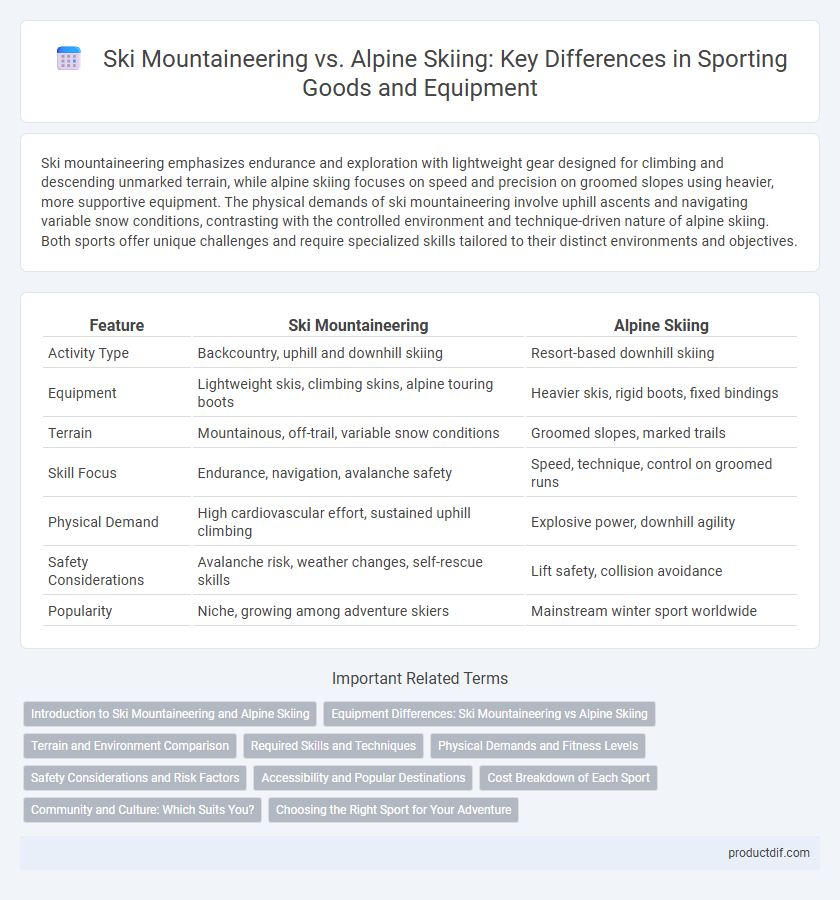Ski mountaineering emphasizes endurance and exploration with lightweight gear designed for climbing and descending unmarked terrain, while alpine skiing focuses on speed and precision on groomed slopes using heavier, more supportive equipment. The physical demands of ski mountaineering involve uphill ascents and navigating variable snow conditions, contrasting with the controlled environment and technique-driven nature of alpine skiing. Both sports offer unique challenges and require specialized skills tailored to their distinct environments and objectives.
Table of Comparison
| Feature | Ski Mountaineering | Alpine Skiing |
|---|---|---|
| Activity Type | Backcountry, uphill and downhill skiing | Resort-based downhill skiing |
| Equipment | Lightweight skis, climbing skins, alpine touring boots | Heavier skis, rigid boots, fixed bindings |
| Terrain | Mountainous, off-trail, variable snow conditions | Groomed slopes, marked trails |
| Skill Focus | Endurance, navigation, avalanche safety | Speed, technique, control on groomed runs |
| Physical Demand | High cardiovascular effort, sustained uphill climbing | Explosive power, downhill agility |
| Safety Considerations | Avalanche risk, weather changes, self-rescue skills | Lift safety, collision avoidance |
| Popularity | Niche, growing among adventure skiers | Mainstream winter sport worldwide |
Introduction to Ski Mountaineering and Alpine Skiing
Ski mountaineering combines uphill climbing and downhill skiing, requiring advanced endurance and navigation skills across backcountry terrain. Alpine skiing emphasizes downhill speed and technique on groomed slopes with marked trails and ski lifts, prioritizing control and performance. Both sports demand specialized equipment, but ski mountaineering often involves lightweight gear for efficient ascents, while alpine skiing relies on heavier, more stable skis for high-speed descents.
Equipment Differences: Ski Mountaineering vs Alpine Skiing
Ski mountaineering equipment emphasizes lightweight and versatility, featuring skis with climbing skins, bindings that allow for both uphill walking and downhill skiing, and boots designed for flexibility and reduced weight. Alpine skiing gear prioritizes stability and control, with heavier, rigid boots, fixed bindings optimized for downhill speed, and skis engineered for carving on groomed slopes. These equipment differences reflect the distinct demands of backcountry mobility in ski mountaineering versus performance and safety on prepared alpine runs.
Terrain and Environment Comparison
Ski mountaineering involves varied terrain including backcountry, ungroomed slopes, and remote mountainous areas requiring navigation through natural obstacles like cliffs and forests. Alpine skiing takes place primarily on groomed resort trails with controlled environments, ski lifts, and safety patrols designed for accessible downhill runs. The environmental challenges in ski mountaineering demand advanced skills in avalanche awareness and weather adaptability, contrasting with the predictable conditions of alpine skiing destinations.
Required Skills and Techniques
Ski mountaineering demands advanced navigation skills, endurance for uphill climbs, and proficiency in using skins and crampons, emphasizing backcountry safety and avalanche awareness. Alpine skiing focuses on high-speed downhill techniques, precise edge control, and effective weight distribution on groomed slopes. Both sports require balance and skiing ability, but ski mountaineering integrates mountaineering skills and terrain assessment for varying snow conditions.
Physical Demands and Fitness Levels
Ski mountaineering demands exceptional cardiovascular endurance, muscular strength, and agility due to prolonged uphill climbing and variable terrain navigation. Alpine skiing emphasizes explosive power, balance, and anaerobic capacity for rapid downhill descents and high-speed turns. Both disciplines require advanced fitness levels, but ski mountaineering involves greater aerobic conditioning and stamina.
Safety Considerations and Risk Factors
Ski mountaineering involves navigating unpredictable mountain terrain, requiring expertise in avalanche awareness, crevasse rescue, and variable weather conditions, which increases risk factors compared to controlled alpine skiing environments. Alpine skiing typically occurs on groomed slopes with ski patrol support, reducing exposure to natural hazards but still posing risks such as high-speed collisions and falls. Proper safety equipment, training, and awareness of environmental conditions are critical in both disciplines to mitigate injury and accidents.
Accessibility and Popular Destinations
Ski mountaineering offers greater accessibility to remote and off-piste mountain areas, appealing to adventure seekers who prioritize backcountry exploration over traditional resorts. Alpine skiing remains dominant in well-established, accessible ski resorts like Whistler Blackcomb, Aspen, and Chamonix, where infrastructure and amenities support diverse skill levels. Popular ski mountaineering destinations include the Alps and the Rockies, known for challenging terrains and minimalist facilities that attract experienced athletes.
Cost Breakdown of Each Sport
Ski mountaineering requires specialized lightweight gear such as touring skis, skins, bindings, and climbing boots, with initial equipment costs ranging from $1,500 to $3,500. Alpine skiing gear typically includes heavier skis, rigid boots, and high-performance bindings, costing between $1,200 and $2,500, but lift pass prices for ski resorts can significantly increase overall expenses. Maintenance costs for both sports include regular tuning and occasional equipment replacement, while ski mountaineering may incur additional expenses for safety gear like avalanche transceivers and backpacks.
Community and Culture: Which Suits You?
Ski mountaineering fosters a tight-knit community centered around adventure, endurance, and exploring remote terrains, attracting enthusiasts who value self-reliance and environmental appreciation. Alpine skiing boasts a larger, more diverse culture with a strong emphasis on accessibility, resort amenities, and social events, appealing to those who enjoy fast-paced, groomed slopes and vibrant apres-ski scenes. Choosing between the two depends on whether you seek a rugged, nature-immersed experience or a bustling, social winter sports environment.
Choosing the Right Sport for Your Adventure
Ski mountaineering demands advanced endurance, technical climbing skills, and lightweight gear for navigating diverse terrains and backcountry routes, making it ideal for adventurous athletes seeking exploration beyond groomed slopes. Alpine skiing offers controlled downhill descents on prepared pistes with reliable ski lifts, suited for those prioritizing speed, technique, and accessibility. Evaluate your fitness level, terrain preference, and equipment investment to select the best discipline that matches your outdoor goals and safety requirements.
Ski mountaineering vs alpine skiing Infographic

 productdif.com
productdif.com